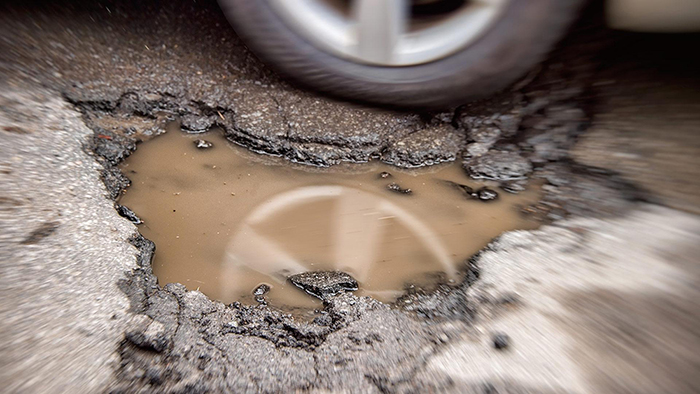Whatever it was, it’s reached the point where winter has worn out its welcome, the streets are begging for mercy and we’ve all had enough of these #$%& potholes.
Professor Charles Schwartz, a pavement engineer for decades and chair of the Department of Civil and
Environmental Engineering, knows more about road damage than any of us. He took time out of his pothole-fighting schedule to talk about why they happen, what can be done to keep them at bay, and (spoiler alert) why we’ll probably never be entirely free of them.
What’s the worst pothole you’ve encountered?
I was going across the East Capitol Street bridge and hit one and blew out a tire and bent one of my alloy wheels.
Do you think potholes this year are particularly bad?
We have had a lot of ups and downs in terms of really cold spells followed by really warm spells, and we've had a lot of precipitation too. So you've got all the ingredients for pothole damage. Just anecdotally, I haven't noticed that this year is worse than others, but then again, anecdotally, there's plenty enough potholes to go around.
Is this area particularly susceptible?
There’s some evidence that if you’re in a zone like ours where you go through multiple freeze-thaw cycles over the course of a winter, versus one where it gets cold and stays frozen, it’s much more damaging. The Pennsylvania DOT has studied that quite a bit. They've got those conditions in the northern part of the state where it stays cold, and to the south they have the freeze-thaw cycles. That's where they see most of their damage.
What’s the typical process for a pothole forming?
Two things: As a road ages, cracks just start forming in the surface, which makes it easier for water to get into the pavement. The other thing is that the asphalt cement, which binds together the gravel and sand and so on, oxidizes and deteriorates over time, particularly at the surface. Moisture can get in and actually destroy the bond between the asphalt cement and the aggregate particles, essentially causing the material to crumble.
How do you stop that?
If you kept a really pristine surface at all times, it would minimize the chances for the development of potholes. But you'd be looking at basically going in every few years and doing what we call a mill-and-fill operation, where you take off the top couple of inches of asphalt and put down new asphalt in its place. Doing that on a frequent basis is pretty expensive.
Are we doomed, or are there any advances to make better roads?
There are a number of things going on. I recently did testing on an infrared pothole repair technique the Pavement Corporation developed that really works well. Hot mix asphalt doesn’t work very well in cold, wet winter conditions. So this locally heats it up and gives a much longer-lasting repair.
One thing I’ve been looking at lately is using more recycling techniques for road rehabilitation. Instead of that mill-and-fill where you remove the top layer and then truck away all that material and dispose of it, you actually use it to make new asphalt concrete. We’re looking at doing this with a cold recycling process instead of the normal method where you heat the asphalt cement to 350 degrees to get it liquid enough to coat the particles. From our studies, in-place recycling and the cold process can reduce carbon emissions by 80 percent and produce concrete that’s nearly as good as conventional hot mix for a lower price.
Meaning it's cheap enough and environmentally responsible to keep the roads in tip-top shape at all times?
Well, we're sort of doing a dance where on the one hand, it'd be nice to go in and do rehabilitation at regular intervals so that the road never deteriorated. On the other hand, you've got irate citizens saying, you just repaved this road three years ago and now you're back out here? So we're looking at techniques that last longer. And maybe we need to tolerate a little bit more deterioration before we go in and do something to it.
Professor Schwartz recently spoke to WAMU 88.5 about the factors that lead to formation of potholes and techniques for fixing them. Read a transcript of the interview.


